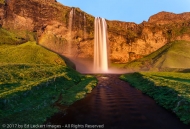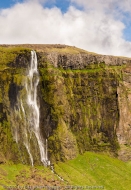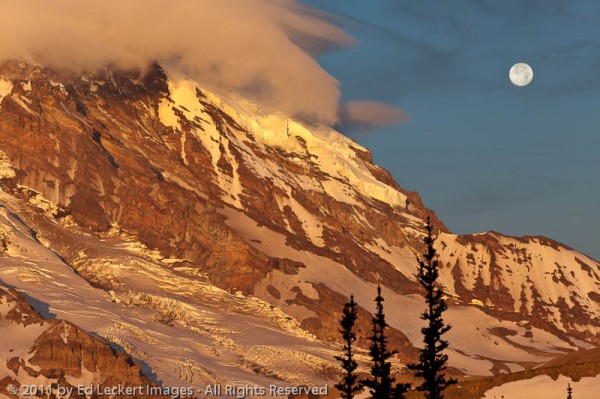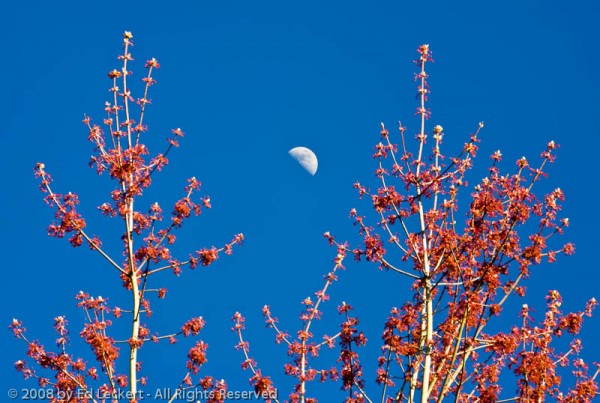


On this day of the new moon, or the “no moon” as I like to call it, I thought it would be fun to go through the archives and see what kind of not-so-new moon images I could find.
Photographers often have difficulty when capturing images of the moon for the first time. They think that because the moon is a celestial object often photographed at nighttime, and not even one with its own light source, that it must be relatively dark and therefore require a longer exposure to capture properly. But think about it a minute. The moon is being lit by the same light source as the earth on a bright sunny day, and it’s essentially the same distance from the sun as the earth. Therefore, unless it’s made of coal, it should reflect about the same amount of light as objects on the earth, and it turns out that it does. So, to get an image of the moon that’s not blown out and has detail, you don’t want to overdo the exposure. This process is a lot easier these days with the instant feedback of digital photography, of course.
Now, as you might expect, every image of the full moon by itself looks just like the next guy’s, technical issues like focus, exposure, camera shake and all that aside. As with any photograph of celestial objects, it’s the use of an earthbound foreground object that makes the difference. In fact, most images look better with a good foreground object, and the moon is no exception.
Because the moon and the earth are similar in brightness during the daytime, and because to get something from the earth into the foreground the moon needs to be at a low angle, it turns out that the best time to get a late afternoon image is the day before a full moon. But if you’re shooting where everything in the landscape is white and the terrain is relatively flat, you can wait until the night of the full moon and still have enough light on the earth to make it work, as in this image taken near the Arctic Circle, eight minutes after sunset.
This next image, on the other hand, was taken at dawn on the day after the full moon. The sun has had enough time to rise and light the landscape before the moon disappears over the horizon, even in mountainous areas like Mount Rainier National Park.

A full moon heads for the horizon as the sun comes up to relieve it, from Sunrise, Mount Rainier National Park, Washington.
If you can find a foreground object high enough in the sky, such as the Seattle Space Needle or a tall tree, then you can shoot any time the moon is passing near that object, during just about any phase, as long as the earthbound object is lighted. In this late afternoon image that was my mother’s favorite, a half-moon passes between two budding trees. Just the thought of budding trees makes me want to sneeze. And it won’t be long now before hay-fever season is in full swing.

The moon rises between two trees with bright red buds on a clear spring morning, in Issaquah, Washintgon.
Anyway, back to the moon. If you don’t need the detail in the moon at all, as in this image where the moon is behind clouds, then you can open up the exposure and let the moonlit earth or reflections be part of the picture.
And finally, there’s the sequence shot of lunar eclipses. By definition, it’s going to be dark on earth when this happens, so the only way to show an earthbound object without blowing out the moon is to take a separate image and combine it, which you’re going to have to do anyway to combine the many moon images during the eclipse. Or you could light paint the object with a flashlight or electronic flash if it’s close enough.
In this image, the foreground exposure was taken at dusk, then combined with 30 images of the moon during the eclipse and one image of the stars and aurora borealis. It was -20°C on the frozen lake that night, so be sure you have good boots when you do this one!

A lunar eclipse takes place above Prelude Lake while the Aurora Borealis puts on a show, in Prelude Lake Territorial Park, Northwest Territories, Canada. All images in this composite were taken on the night of the eclipse from the same camera position with the same lens and focal length. Only the exposure was adjusted during the night.
So what have we learned? Well, I’ve learned that I don’t have nearly as many moon images as I should have, so I need to get busy! Fortunately, I already have a trip planned around the next full moon, so wish me luck!
